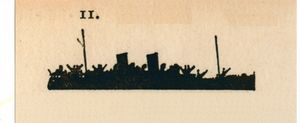RMS Maloja
| RMS Maloja | |
|
| |
| Career | |
|---|---|
| Nationality | British |
| Owner: | Peninsular & Oriental Steam Navigation Company. |
| Ordered: | 1918, Yard No 588 |
| Builder: | Messrs Harland & Wolff,Ltd,Belfast. |
| Launched: | 19 April 1923 |
| Maiden voyage: | 2 November 1923 |
| Fate: | P & O group service 1923 to 1954. Scrapped on 2 April 1954, Inverkeithing. |
| General characteristics | |
| Tonnage: | 20,837 gross tons. 12,830 net tonnage. Deadweight 15,900 tonnes (15,650 tons) |
| Length: | 600.8 feet |
| Beam: | 73.4 feet |
| Depth | 43.5 feet. Draught 34.10 feet |
| Propulsion: | 2 Quadruple-expansion steam engines, producing 15,300 shaft horse power (13,300 ihp). Inverted direct acting, balanced to eliminate vibrations. Twin screw. Boilers: 6 D.E. and 2 S.E. Boilers with a steam pressure of 215 lb/in². Fuel: Oil |
| Speed: | 16 knots |
| Paintwork | Black hull with white line, red boot-topping, upper works stone, funnels black. |
| Complement: | 327 First Class, 329 Second Class, Crew: 423 made up of 10 officers, 94 seamen, 22 engineers, 82 firemen and 215 saloon crew. |
RMS Maloja was an English steam-powered ocean liner that saw service during the first part of the twentieth century.
The Peninsular and Oriental Steam Navigation Company placed the order for RMS Maloja with Harland and Wolff Ltd on 29 November 1918. Yard No. 588 was assigned to the project and work began in the Belfast shipyard. On the same date, an order was placed for a sister ship, RMS Mooltan. The interior design was in keeping with the high standards of the Line. The public rooms were luxurious, completely decorated and lofty. All first and second class cabins had portholes. The dining saloon seated 330; it was panelled in the Georgian style, finished throughout in ivory white, with the doors and architraves in polished mahogany. The reading and music saloon was in the style of Louis XVI with large French windows. RMS Maloja was launched by Hon. Elsie Mackay the daughter of the company's chairman James Mackay, 1st Earl of Inchcape, on 19 April 1923. The Maloja and the Mooltan would eventually earn a reputation for comfort and reliability. Maloja was delivered on 25 October 1923. The two ships were the largest ships that could comfortably pass through the Suez Canal at that time.
Contents
Maiden voyage
On 2 November 1923 RMS Maloja took to the ocean on its maiden voyage. Its design had emphasised reliability and comfort over speed. It had broad decks and rode steadily, although (because of a small rudder) it would prove to have difficult handling. On 18 January 1924 the two ships began running the fortnightly service between London and Sydney via Colombo and Melbourne. In November 1923 Maloja became enmeshed in a dockworkers' strike in Australia and after a delayed departure was forced to abandon 6,000 tons of cargo sitting on the dockside. In March 1933 Maloja ran aground in Adelaide but was re-floated without sustaining significant damage. In January 1933 Maloja was in Gibraltar Bay, loading cargo from a lighter in severe weather. An anchor and 45 fathoms (82 m) of chain pulled free and were lost.
Wartime requisition
On 11 September 1939 Maloja was requisitioned by the Admiralty and converted to an armed merchant cruiser in Bombay, India. The conversion included having one funnel removed, to increase the arc of the anti-aircraft guns. After the conversion it joined the Northern Patrol as H.M.S. Maloja, No. F26. The Northern Patrol covered the area between Shetland and Iceland. On 13 May 1940 Maloja intercepted a ship southeast of Iceland in position 63.00N, 10.20W, which claimed to be the Japanese vessel Taki Maru. The Maloja captain suspected otherwise, but he was unable to send a boarding party due to the adverse weather conditions. As the weather cleared it became clear that the unknown vessel was German, namely, the La Coruna of the Hamburg South American line. The German crew scuttled her to evade its capture, and after they had abandoned ship and been picked out of the water by the English crew, Maloja turned its guns on the German ship and hastened its submersion.
On 6 November 1941 Maloja was returned to P & O and was converted to troopship duty. A shorter version of the funnel was re-installed. On 11 December 1942 the ship took part in the Allied landings in North Africa.
Peacetime and the return to commercial services
On 15 January 1947 RMS Maloja was returned once more to P & O and was berthed at the Royal Albert Dock in London for full civilian reconditioning, by R & H Green & Silley Weir. Both Maloja and Mooltan were returned to service. After the independence of the Republic of Indonesia in 1948 the repatriation of Dutch civilians back to the Netherlands was begun. In August 1950 Maloja assisted with the repatriations and this was completed by 1951. On 19 January 1954 Maloja arrived at the Tilbury, London, on its last voyage. On 2 April 1954 it was moved to Inverkeithing, Scotland, where it was broken up for scrap. British Iron and Steel Corporation (Salvage) Ltd paid £165,000 for the vessel; the scrap work was performed by Thomas W Ward Ltd.


